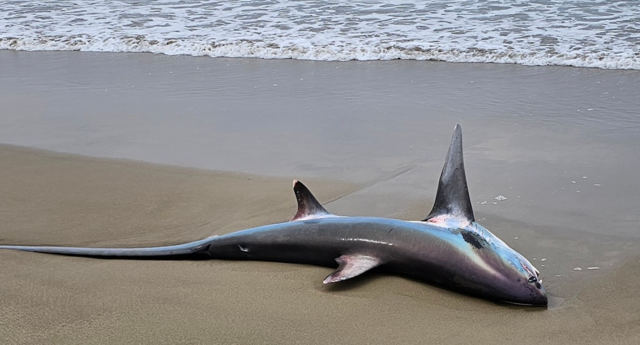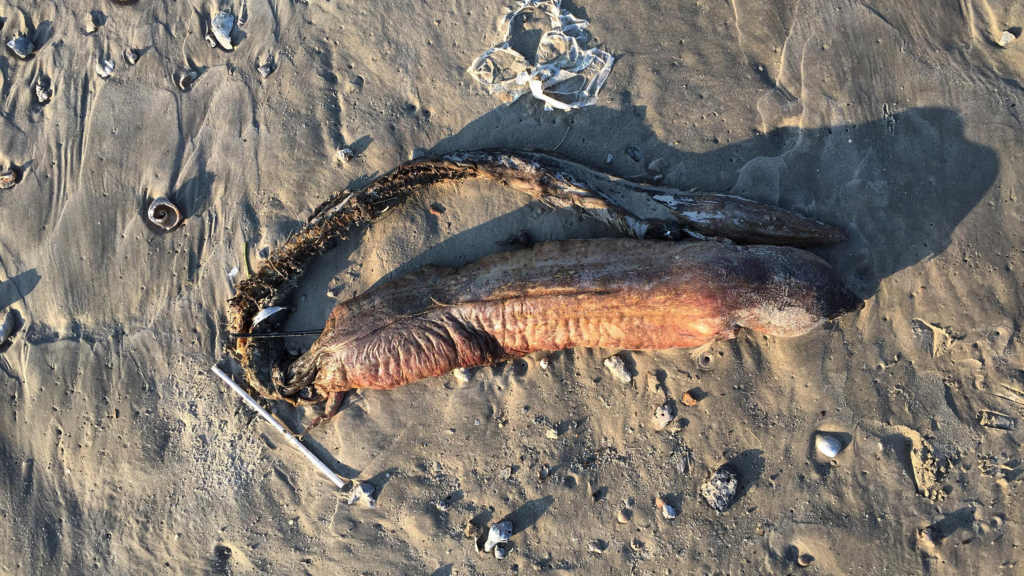Thresher Shark sightings are rare, but a few days ago, visitors to Seven Mile Beach in New South Wales, Australia, were startled by the appearance of one such creature washed ashore.
The Thresher Shark, known for its distinctive long tail, drew significant attention as it lay on the beach. Spanning three metres in length, this deep-sea shark presented a fascinating yet eerie sight for those who came across it.
Unveiling the Thresher Shark: A Rare Sight
The Thresher Shark, Alopias vulpinus, is not a common species to be found on beaches, especially not in such a state. This particular shark, as confirmed by Amanda Hay, the Ichthyology collection manager at the Australian Museum, belongs to a family of sharks recognized for their elongated upper caudal fins.
These fins, or tails, often match the length of their bodies, giving the Thresher Shark a distinctive silhouette in the deep sea.
Photos of the shark, shared on social media by those who encountered it, showed it was already dead when found. Some spectators noted missing teeth and injuries that suggested a violent end.
Read : Tsunami Warning Mistakenly Sent by Australia’s Bureau of Meteorology
“Seems like it just washed in with the tide,” one observer commented online. “Some heavy bites to the snout but the worst damage seemed underneath as it was bleeding heavily.”
Read : Why Only New Zealand and Australian Land Will Be Cultivable If a Nuclear War Happens
While the Thresher Shark is typically a shy creature of the ocean, its appearance on the shore raised questions about what could have caused it to wash up dead.
Understanding the Features of the Thresher Shark
The Thresher Shark is unique in its appearance, setting it apart from other shark species in several ways. Its upper lobe of the caudal fin is particularly striking due to its length. In fact, this long tail helps the shark hunt, allowing it to stun prey with quick, whip-like movements.

Amanda Hay highlighted that the shark’s large eyes and coloration also distinguish it. “It can be differentiated from the other species by the length of the upper lobe of the caudal fin, the size of the eye, but most distinctively, the white from the underside extends above the pectoral fin, where it is grey in the other two species,” she noted.
Although this Thresher Shark was found injured, it’s still unclear what caused its demise. The heavy bites on its snout suggest a potential attack from a larger marine predator.
However, washing up on the beach is not unusual for dead marine creatures. Various environmental factors, including strong ocean currents, can carry dead sharks ashore, where they end up being discovered by beachgoers.
The Thresher Shark is native to Australian waters, particularly around the Brisbane area, southern Australia, the North West Shelf, and even Tasmania. They can also be spotted near New Zealand. However, the sight of one washed ashore like this remains an uncommon occurrence.
Climate Change and Its Impact on Shark Movements
One of the critical factors that may have contributed to the Thresher Shark appearing on the shore is climate change. Marine Biologist Lawrence Chlebeck, from the Humane Society International (HSI), explained that the shifting climate could be leading to changes in ocean currents, which might be bringing unusual species into unfamiliar areas.
“Often bringing unexpected species into new areas,” Chlebeck said, referring to how environmental shifts can disrupt marine life.
As ocean temperatures rise, many marine creatures are forced to move into different habitats, which can sometimes result in vulnerable species like the Thresher Shark wandering into unknown waters or closer to shore.

Although it’s uncertain whether this particular Thresher Shark fell victim to climate change-induced factors, the possibility cannot be ruled out. As currents shift and temperatures fluctuate, sharks and other marine animals may find themselves in foreign waters, where their chances of survival could be significantly reduced.
The Thresher Shark itself is classified as “vulnerable” by the World Conservation Union. This classification is a reflection of the increasing pressures on its population due to overfishing and habitat degradation. The long tails that make these sharks unique also put them at risk, as they are often caught in fishing nets.
With climate change continuing to affect marine ecosystems, Chlebeck warns that more sightings like this could become the norm. Sharks and other deep-sea creatures may begin to appear in places where they have rarely been spotted before, driven by changing ocean patterns and diminishing food sources.
Why Did the Thresher Shark Wash Ashore?
The exact reason for this Thresher Shark washing ashore remains a mystery. While Amanda Hay and other experts have noted the shark’s injuries, they cannot definitively say what happened to it. It’s possible the shark was attacked by another, much larger marine animal, or it could have suffered injuries from other environmental hazards.

Dead fish and marine creatures washing up on beaches is not uncommon, especially in regions where strong tides and shifting currents prevail. However, it’s clear that the sight of such a rare Thresher Shark on an Australian beach has sparked curiosity and concern among the public.
Shark species are generally elusive and prefer the depths of the ocean, far from the human eye. But when creatures like the Thresher Shark wash ashore, it serves as a reminder of the changing conditions in our oceans and the potential dangers these animals face in their natural habitats.
This sighting on Seven Mile Beach may not be the last. With continued shifts in climate patterns, we may witness an increase in rare marine animals making their way to unexpected locations, either by choice or due to the evolving ocean currents. The Thresher Shark, with its long, elegant tail and vulnerable status, remains a symbol of both the mysteries and fragility of the deep sea.

